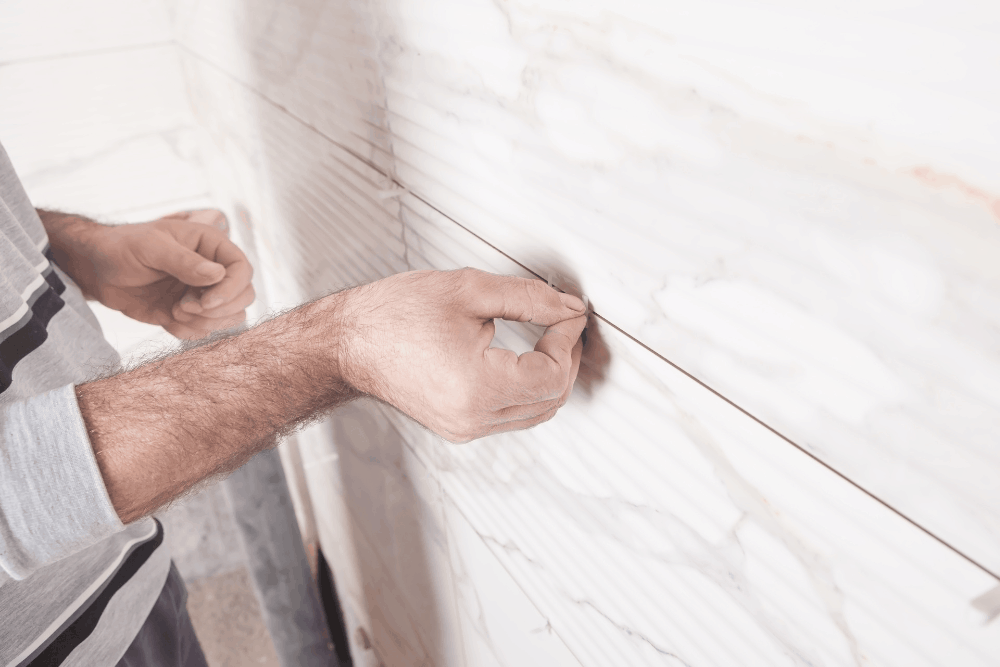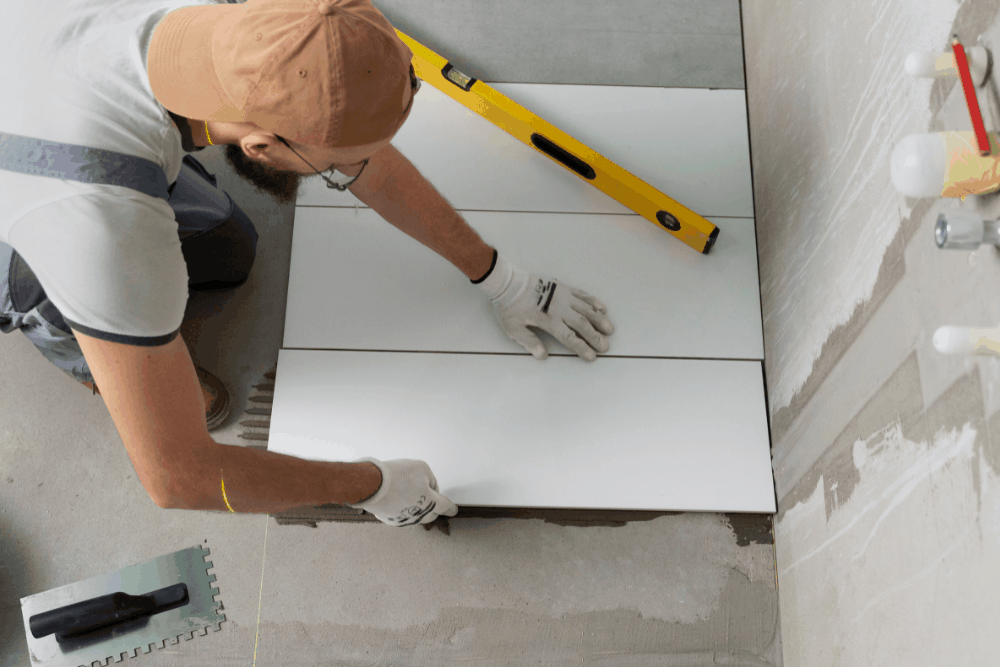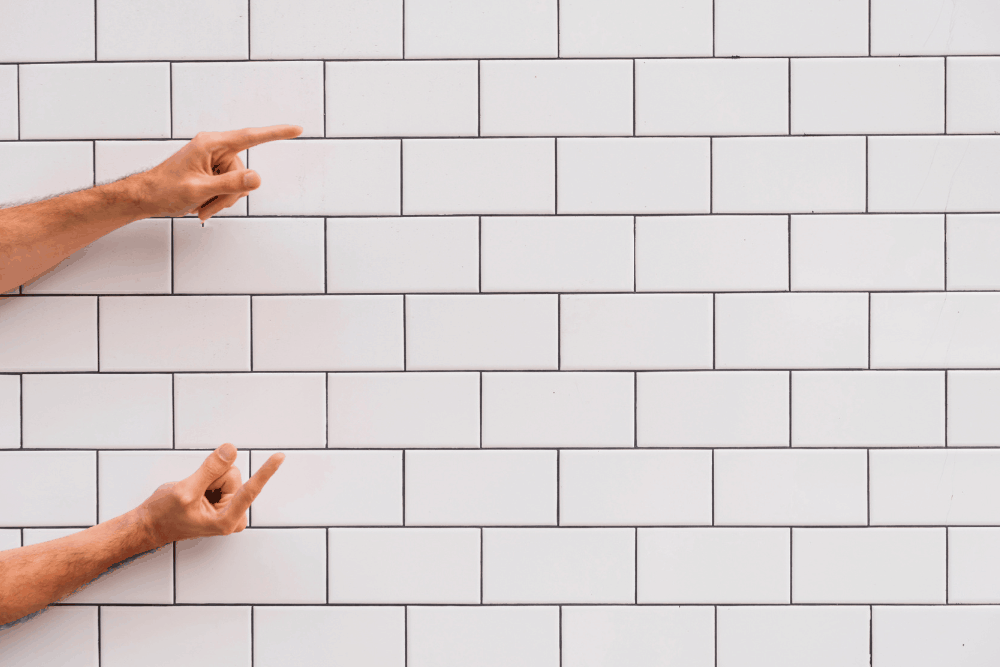
Tired of looking at worn, discolored, or outdated bathroom tiles? Bathroom tile resurfacing offers a cost-effective solution that can completely transform your space without the expense and disruption of full replacement. This innovative process involves applying specialized coatings to existing tiles, restoring their appearance and extending their lifespan significantly.
Whether you’re dealing with stubborn stains, minor surface damage, or simply want to modernize your bathroom’s aesthetic, resurfacing provides an excellent alternative to costly renovations. Professional contractors like Bay Tile understand the complexities of tile restoration and can help determine the best approach for your specific needs. With proper execution, resurfaced tiles can look brand new and last for years with minimal maintenance. Professional expertise in tile installation services ensures optimal results and long-term satisfaction.
What Is Bathroom Tile Resurfacing?
Understanding the fundamentals of tile resurfacing helps homeowners make informed decisions about their renovation projects. This process involves much more than simply painting over existing tiles.
Resurfacing bathroom tiles is a specialized technique that involves thorough cleaning, repair, and coating of existing tiles with materials designed to restore their original beauty. The process addresses common issues like persistent staining, minor chips, surface scratches, and general wear without requiring complete tile removal. This method works exceptionally well on ceramic, porcelain, and natural stone surfaces that have maintained their structural integrity but lost their visual appeal over time.
When Should You Consider Resurfacing Instead of Replacing?
Resurfacing becomes the ideal choice when your tiles are structurally sound but show signs of surface deterioration. If your tiles remain properly adhered to walls or floors, are free from major cracks, and the underlying substrate stays stable, resurfacing can deliver outstanding results. This approach proves particularly beneficial for homeowners seeking to update their bathroom’s appearance without enduring the disruption of complete demolition and reconstruction.
Benefits of Tile Resurfacing
The advantages of choosing resurfacing over replacement include substantial cost savings, dramatically reduced project timelines, and minimal disruption to your daily routine. Most professional resurfacing projects can be completed within just a few days, compared to the weeks typically required for full tile replacement. Additionally, this environmentally conscious method eliminates the need for disposing of old materials, reducing waste and environmental impact.
How to Resurface Bathroom Tile Step-by-Step

Learning how to resurface bathroom tile empowers homeowners to understand the process and make educated decisions about their renovation investments. Bay Tile’s experienced professionals follow proven methodologies to ensure exceptional results.
The resurfacing process begins with meticulous surface preparation, followed by primer application, coating application, and final sealing. Each step requires specific techniques, quality materials, and professional expertise to ensure lasting, beautiful results that stand up to daily bathroom use.
Tools and Materials You’ll Need
Essential tools include specialized sanders, high-quality brushes, professional-grade rollers, and comprehensive protective equipment. Materials typically consist of bathroom-specific primers, advanced resurfacing coatings, and durable sealers designed to withstand moisture and daily wear. The quality of these materials directly impacts both the longevity and final appearance of your resurfaced tiles.
Preparing the Tile Surface
Proper preparation forms the critical foundation of successful resurfacing bathroom tiles. This comprehensive process involves deep cleaning to remove soap scum and residue, repairing any existing damage, and ensuring the surface is completely dry and free from all contaminants. Professional preparation often includes light sanding to create optimal adhesion for the new coating system.
Applying the Resurfacing Coating
The coating application requires precise technique, proper timing, and professional expertise to achieve flawless results. Multiple thin coats typically produce superior results compared to single thick applications. Proper ventilation and temperature control during application ensure optimal curing and achieve the desired final appearance.
Sealing and Curing Time
Proper curing is absolutely essential for achieving long-lasting, durable results. Most professional-grade resurfacing products require 24-48 hours of initial curing time before light use, with complete cure occurring over several days. During this critical period, avoiding moisture exposure ensures optimal bonding and maximum durability.
Safety Precautions
Working with resurfacing materials requires proper ventilation, appropriate protective equipment, and strict adherence to manufacturer safety guidelines. Many products contain specialized chemicals that require careful handling and proper disposal methods.
Bathroom Tile Resurfacing Cost: What to Expect

Understanding pricing helps homeowners budget effectively for their bathroom renovation projects. Bay Tile provides transparent pricing and detailed estimates for all resurfacing services.
Bathroom tile resurfacing cost varies significantly based on surface area, existing tile condition, material choices, and project complexity. Understanding these key variables helps homeowners develop realistic budgets and make informed decisions about their renovation investments.
Average Cost per Square Foot
Professional resurfacing bathroom floor tiles typically ranges from $3 to $7 per square foot, representing significant savings compared to complete replacement costs. Wall tile resurfacing often falls within a similar price range, though complex patterns, intricate designs, or extensively damaged areas may require additional investment for optimal results.
DIY vs Professional Resurfacing Prices
While DIY approaches can reduce initial labor costs, professional installation often provides superior long-term value through proper preparation, expert application techniques, and comprehensive warranty protection. The complexity of bathroom tile installation and resurfacing requires specialized expertise to achieve professional-quality results that last.
Factors That Affect Cost
Surface condition, accessibility, material choices, and project scope significantly impact final pricing. Damaged tiles requiring extensive repair, intricate patterns, premium coating materials, or challenging installation conditions increase overall project costs but often deliver superior long-term value.
Resurfacing vs Installing New Tiles: Which Is Right for You?
Making the right choice between resurfacing and replacement depends on multiple factors. Bay Tile’s experts can assess your specific situation and recommend the most cost-effective solution.
Choosing between resurfacing and complete replacement depends on your tiles’ structural condition, available budget, design goals, and long-term expectations. Resurfacing works exceptionally well when existing tiles remain structurally sound but need cosmetic improvement. New installation becomes necessary when tiles are loose, extensively cracked, or the underlying surface requires significant repair.
Tips to Extend the Life of Your Resurfaced Tiles
Maximizing your investment requires proper maintenance and care. Bay Tile provides comprehensive maintenance guidance to help clients preserve their resurfaced tiles for years to come.
Proper maintenance and care practices maximize the lifespan of resurfaced surfaces and protect your renovation investment. Regular cleaning with appropriate products, avoiding harsh chemicals, and addressing minor issues promptly help preserve the coating’s integrity and appearance.
Proper Cleaning and Maintenance
Use pH-neutral cleaners and soft cloths to maintain your resurfaced tiles and preserve their appearance. Avoid abrasive scrubbers that can damage the protective coating surface. Regular maintenance prevents buildup that can compromise the resurfacing material’s appearance and long-term durability.
Avoiding Damage from Harsh Products
Acidic cleaners, bleach-based products, and abrasive tools can permanently damage resurfacing coatings and void warranties. Choose cleaning products specifically formulated for resurfaced surfaces to maintain their appearance, performance, and longevity.
When to Reseal or Recoat
Most professionally resurfaced tiles benefit from resealing every 2-3 years, depending on usage patterns and maintenance practices. Bathroom floor tile resurfacing may require more frequent attention due to higher foot traffic and increased moisture exposure. Professional assessment can determine when recoating becomes necessary to maintain optimal performance and appearance.
